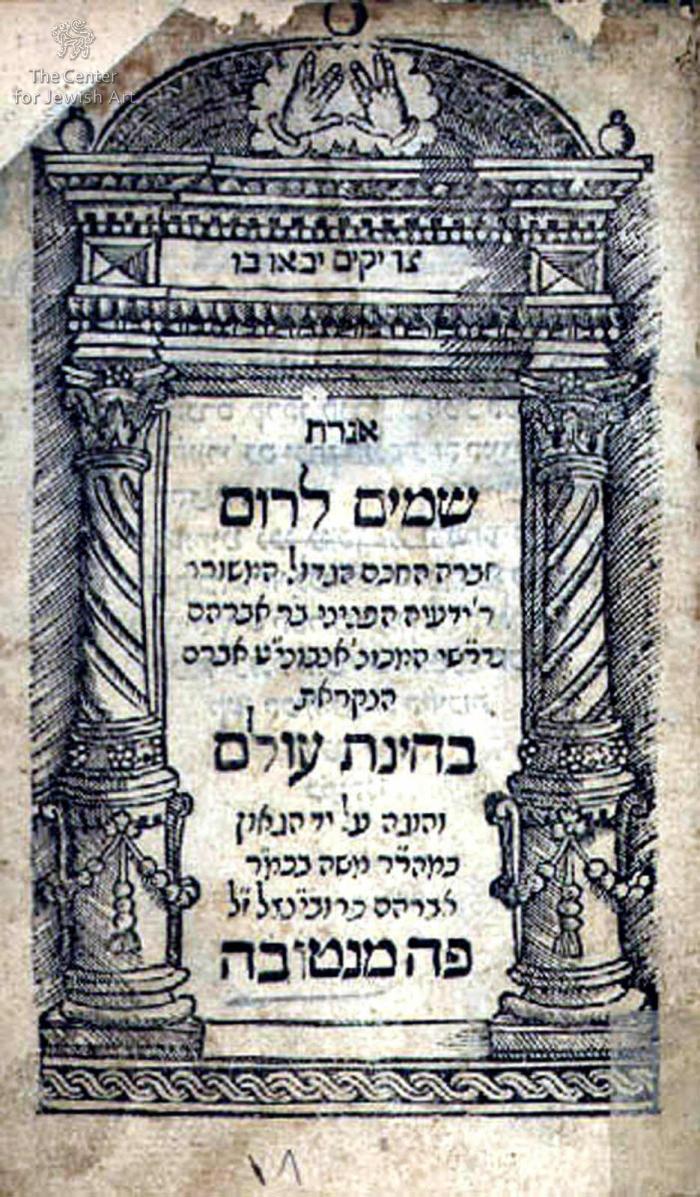Obj. ID: 38949
Jewish printed books Bechinat Olam by Yedidyah ben Avraham Habadrah Penini, Mantua, 1556

This text was prepared by William Gross:
One of the early books printed in the 16th century in Mantua, employing a classic gate motif title page. The printer mark, the hands of the Cohanim, is presented at the top of the page as a part of the design.
Sefer Bechinat Olam (Contemplation of the World) is the best-known literary work of Yedidyah b. Avraham Bedersi. It is a poetical and philosophical work on the vanity of worldy things and the inestimable benefits of intellectual and religious pursuits. It is also known as "Shamayim la-Rom" (Heaven's Height) from its initial words. I was written after the expulsion of the Jews from France in 1306, an event referred to in the book.
Yedidyah ha-Penini b. Avraham Bedersi (c.1270 – c.1340) (Hebrew: ידעיה הבדרשי) was a Jewish poet, physician, and philosopher; born at Bיziers. His Provenחal name was En Bonet, which probably corresponds to the Hebrew name Tobiah. According to the practice of the Provenחal Jews, he occasionally joined to his name that of his father, Abraham Profiat (Bedersi). In his poems, Bedersi assumed the appellation "Penini" (הפניני, Dispenser of Pearls). It is because of this appellation that the ethical work Mivhar Peninim of Solomon ben Gabirol (printed together with Bechinat Olam) has been erroneously ascribed to Bedersi.
Bechinat Olam enjoyed the greatest success. Published first at Mantua by Estellina, wife of Abraham Conat, between 1476 and 1480, the work now exists in more than 80 editions, with and without commentaries, including translations into several European languages. The poem was translated into Latin by Uchtman; into German by Isaac Auerbach, Hirsch ben Meïr, Joel ben Joseph Faust or Wust, Simson Hamburger, Auerbach (who made use of a translation of parts iv. and v. by Mendelssohn), J. Levy, Joseph Hirschfeld, and (in verse) by Stern, preceded by an interesting Hebrew introduction by Weiss; into French by Philippe Aquinas and Michel Beer; into Italian in Antologia Israelitica, 1880,pp. 334 et seq.; into English by Tobias Goodman; into Polish by J. Tugendhold.
The printer, Jacob b. Naftali ha-Kohen of Gazzuolo had also worked at the Sabbioneta press. Upon coming to Manuta, Bechinat Olam was one of his first two titles. He later became partners wtih Meir b. Ephraim of Padua, and together their press issued many kabbalistic and other important works. The hands of the Kohanim, reflecting Jacob's Cohanic status, can be seen at the top of the title page.



